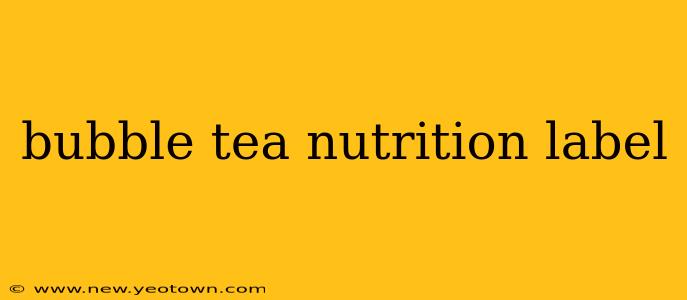Bubble tea. The vibrant, customizable, and undeniably delicious beverage that's taken the world by storm. But behind that delightful swirl of tea, milk, and chewy tapioca pearls lies a nutritional landscape that can be surprisingly complex. Let's dive into the world of bubble tea nutrition labels and unravel the sweet truths (and sometimes not-so-sweet realities) hidden within.
Imagine this: It's a hot summer afternoon, and the tempting aroma of freshly brewed bubble tea wafts through the air. You choose your favorite flavor, your preferred level of sweetness, and before you know it, you're happily slurping away. But have you ever paused to consider what's actually in that delicious cup? The nutrition label holds the key. However, understanding it can be tricky.
What's Typically Included on a Bubble Tea Nutrition Label?
Most bubble tea shops will provide a nutrition label, either printed on a menu or available upon request. These labels typically include the following information per serving:
- Serving Size: This is usually expressed in ounces or milliliters. Be aware that many bubble tea servings are quite large!
- Calories: The total energy content of the beverage. This is a crucial figure for managing your daily caloric intake.
- Total Fat: This includes saturated and unsaturated fats from the milk or cream used.
- Cholesterol: Relevant if using dairy-based milk alternatives.
- Sodium: Often from added salt or salty toppings.
- Total Carbohydrate: This is usually the highest value and includes sugars from the tea base, added sweeteners, and the tapioca pearls.
- Sugars: This shows the amount of added sugar, which can be substantial in sweeter drinks.
- Protein: Usually a low value unless a protein powder is added.
How Much Sugar is Actually in Bubble Tea?
This is often the biggest surprise for many bubble tea lovers. The sugar content can vary wildly depending on the size of the drink and, critically, the level of sweetness selected. A "full sugar" drink can easily contain upwards of 50-70 grams of sugar – that's more than the recommended daily intake of added sugar for many adults! Opting for less sugar significantly reduces the sugar content.
Are Bubble Tea Pearls Healthy?
Tapioca pearls, the signature chewy addition to bubble tea, are primarily made from tapioca starch. While they provide a small amount of carbohydrates and some calories, they are not considered a significant source of nutrients. They are essentially empty calories.
What are the Alternatives to Regular Milk in Bubble Tea?
Many bubble tea shops now offer healthier alternatives to traditional milk, including:
- Soy Milk: A lower-fat and often lower-calorie option.
- Almond Milk: Lower in calories and fat than dairy milk.
- Oat Milk: A creamy alternative with a slightly higher calorie count than almond milk.
- Non-Dairy Creamers: Various options are available, but check the nutrition label as they can be high in sugar and fat.
Choosing a non-dairy milk option can help reduce the fat and cholesterol content of your bubble tea.
How Can I Make My Bubble Tea Healthier?
Making healthier choices when enjoying bubble tea is completely possible! Here are some tips:
- Choose a smaller size: Less overall calories and sugar.
- Reduce the sweetness level: A significant impact on sugar content.
- Opt for non-dairy milk alternatives: Lower the fat and cholesterol.
- Select less sugary flavor options: Some fruit flavors naturally contain less sugar than others.
- Choose fresh fruit additions: Avoid sugary syrups.
- Enjoy it occasionally: Like any treat, moderation is key.
Understanding the nutritional information on your bubble tea label empowers you to make informed choices and indulge in this delightful treat responsibly. Remember to look beyond the flavor and consider the nutritional content to truly savor your bubble tea experience.

